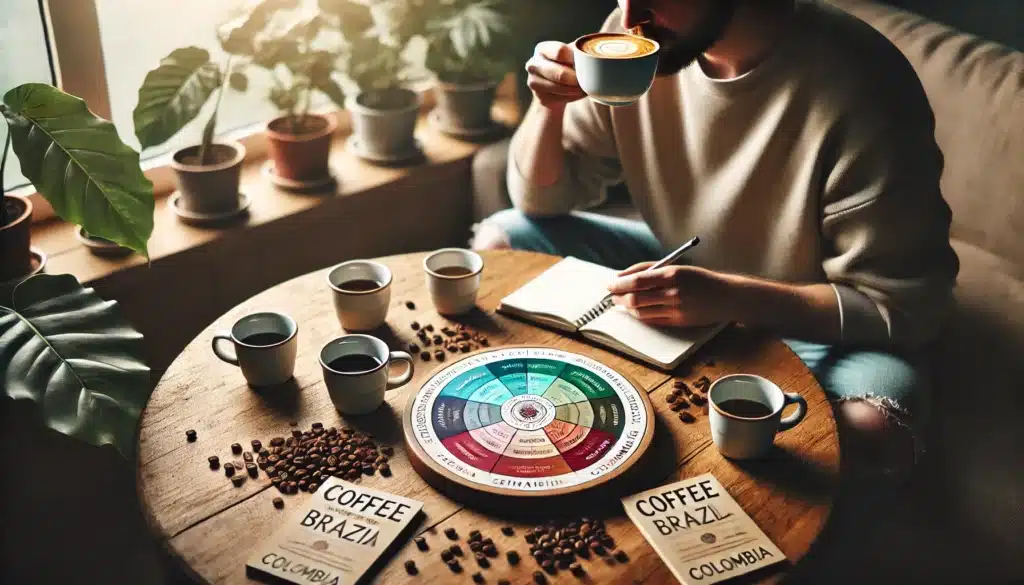Tasting coffee is like learning a new language — one of aromas, textures, acidity, and subtle notes. Developing a refined palate doesn’t happen overnight, but with consistent practice and curiosity, anyone can train their senses to recognize the nuances in every cup.
In this guide, you’ll learn how to strengthen your tasting skills, expand your vocabulary, and become more confident in describing and enjoying the complex world of coffee.
1. Taste Mindfully, Not Automatically
The first step to refining your palate is intentional tasting. Instead of drinking coffee passively, ask:
- What do I smell before and after brewing?
- What do I taste at the beginning, middle, and end?
- What lingers after I swallow?
Mindful tasting builds awareness of subtle differences.
2. Use a Flavor Wheel
The Coffee Taster’s Flavor Wheel is a great training tool.
Start broad: fruity, nutty, sweet, floral
Then narrow down: citrus → orange → mandarin
Refer to the wheel during tastings to expand your vocabulary and better identify flavors.
3. Compare Coffees Side by Side
One of the best ways to train your palate is by comparative tasting.
Try:
- Two different origins (e.g., Ethiopia vs. Brazil)
- Two roast levels of the same bean
- Washed vs. natural processing
Side-by-side comparisons highlight contrasts and help you detect subtle differences more clearly.
4. Practice Describing What You Taste
After tasting, write down your impressions. Use sensory language like:
- Sweet like honey
- Bright like green apple
- Rich like dark chocolate
- Smooth, creamy, crisp, juicy
Don’t worry about being “correct” — the goal is to build confidence and precision in describing what you experience.
5. Train Your Nose Daily
Much of taste comes from smell. Strengthen your olfactory sense by smelling:
- Herbs and spices
- Fruits and flowers
- Chocolates and nuts
Close your eyes, smell slowly, and name the aroma. This builds scent memory — essential for identifying coffee notes.
6. Taste Ingredients Separately
Expand your palate by tasting flavor components on their own:
- Slice citrus fruits and compare acidity
- Taste nuts and chocolates with different roast levels
- Brew herbal teas to compare floral and earthy notes
This helps connect familiar tastes with what you find in coffee.
7. Focus on Acidity, Sweetness, and Body
With each cup, pay attention to:
- Acidity: Is it bright, sharp, or soft?
- Sweetness: Is it sugary, syrupy, or fruity?
- Body: Is it light like tea or heavy like syrup?
Training these three dimensions helps build a solid sensory foundation.
8. Revisit the Same Coffees Over Time
Don’t rush to try something new every day. Instead:
- Brew the same coffee in different ways
- Taste it fresh, then 2 weeks later
- Compare with food pairings
Repetition reveals new layers and deepens understanding.
9. Attend Cuppings or Guided Tastings
Join public cuppings at your local roaster or café. These sessions:
- Introduce you to new beans and origins
- Offer expert guidance on sensory analysis
- Allow group discussion to expand your perspective
They’re one of the best ways to grow your palate in a supportive setting.
10. Stay Curious and Open
Your palate evolves. What seems too acidic today may become your favorite flavor next month.
Stay curious:
- Try different origins and processes
- Explore new brew methods
- Keep an open mind and taste everything
Learning to taste is a journey — one delicious sip at a time.
Final Thoughts: Taste Is a Skill, Not a Talent
Refining your coffee palate isn’t about perfection — it’s about practice, patience, and play. With each cup, you sharpen your senses and deepen your appreciation for the artistry behind great coffee.
Keep tasting, keep learning, and trust your tongue. It knows more than you think.







